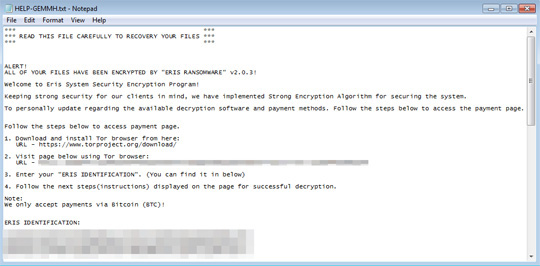Ransom.Win32.ERIS.C
Trojan-Ransom.Eris (IKARUS); a variant of Win32/Filecoder.Eris.B trojan (NOD32)
Windows


Threat Type: Ransomware
Destructiveness: No
Encrypted: No
In the wild: Yes
OVERVIEW
This Ransomware arrives on a system as a file dropped by other malware or as a file downloaded unknowingly by users when visiting malicious sites.
It connects to certain websites to send and receive information. It deletes itself after execution.
TECHNICAL DETAILS
Arrival Details
This Ransomware arrives on a system as a file dropped by other malware or as a file downloaded unknowingly by users when visiting malicious sites.
Installation
This Ransomware adds the following processes:
- taskkill.exe /f /im mysqld.exe
- taskkill.exe /f /im sqlwriter.exe
- taskkill.exe /f /im sqlserver.exe
- taskkill.exe /f /im MSExchange*
- taskkill.exe /f /im Microsoft.Exchange.*
Process Termination
This Ransomware terminates processes or services that contain any of the following strings if found running in the affected system's memory:
- sql
- backup
- malware
- server
- agent
- http
- apache
Dropping Routine
This Ransomware drops the following files:
- %ProgramData%\00000000.pky → contains public key
- %ProgramData%\00000000.eky → contains encryption key
- %ProgramData%\00000000.ext → contains file extension of encrypted files
(Note: %ProgramData% is a version of the Program Files folder where any user on a multi-user computer can make changes to programs. This contains application data for all users. This is usually C:\ProgramData on Windows Vista, 7, 8, 8.1, 2008(64-bit), 2012(64-bit) and 10(64-bit), or C:\Documents and Settings\All Users on Windows Server 2003(32-bit), 2000(32-bit) and XP.)
Other Details
This Ransomware connects to the following URL(s) to get the affected system's IP address:
- http://extreme-ip{BLOCKED}.com/json
It connects to the following website to send and receive information:
- http://{BLOCKED}wzczbcbi4edpi4tx3khwbnty3obfhemd5i5gbyci3hxx3k5pad.{BLOCKED}n.pet/api/v1/check
- http://{BLOCKED}wzczbcbi4edpi4tx3khwbnty3obfhemd5i5gbyci3hxx3k5pad.{BLOCKED}n.pet/api/v1/sync
It does the following:
- It deletes the shadow volume copies and disables system recovery using the following commands:
- vssadmin delete shadows /all /quiet
- wmic shadowcopy delete
- wbadmin delete catalog -quiet
- bcdedit /set {default} bootstatuspolicy ignoreallfailures
- bcdedit /set {default} recoveryenabled no
- It wipes deleted files from encrypted drives using the following command:
- cipher /W:{Encrypted Drive Letter}:
It deletes itself after execution.
Ransomware Routine
This Ransomware avoids encrypting files with the following strings in their file name:
- .sys
- .com
- autoexec.bat
- boot.ini
- ntdetect.com
- msdos.sys
- io.sys
- pagefile.sys
- ntuser.dat
- config.sys
- ntldr
It avoids encrypting files found in the following folders:
- windows
- windows.old
- system volume information
- $recycle.bin
- program files
- program files (x86)
- programdata
- i386
- amd64
- sysvol
It appends the following extension to the file name of the encrypted files:
- .{5 random characters}
It leaves text files that serve as ransom notes containing the following text:
- {Encrypted Directory}\HELP-{5 random characters}.txt

SOLUTION
Step 1
Trend Micro products with the XGen technology detect this malware as
- Troj.Win32.TRX.XXPE50FFF031
Step 2
Before doing any scans, Windows 7, Windows 8, Windows 8.1, and Windows 10 users must disable System Restore to allow full scanning of their computers.
Step 3
Note that not all files, folders, and registry keys and entries are installed on your computer during this malware's/spyware's/grayware's execution. This may be due to incomplete installation or other operating system conditions. If you do not find the same files/folders/registry information, please proceed to the next step.
Step 4
Search and delete these components
- %ProgramData%\00000000.pky
- %ProgramData%\00000000.eky
- %ProgramData%\00000000.ext
- {Encrypted Directory}\HELP-{5 random characters}.txt
Step 5
Scan your computer with your Trend Micro product to delete files detected as Ransom.Win32.ERIS.C. If the detected files have already been cleaned, deleted, or quarantined by your Trend Micro product, no further step is required. You may opt to simply delete the quarantined files. Please check the following Trend Micro Support pages for more information:
Step 6
Restore encrypted files from backup.
NOTES:
- Enabling Volume Shadow Service
- Run the command prompt (cmd.exe) as administrator.
- Enable volume shadow service using the following command:
net start vss
- Enabling Windows Error Recovery
- Run the command prompt (cmd.exe) as administrator.
- Enable Windows error recovery screen on startup using the following command:
bcdedit /set {default} bootstatuspolicy displayallfailures
- Enabling Startup Repair
- Run the command prompt (cmd.exe) as administrator.
- Enable startup repair using the following command:
bcedit /set {default} recoveryenabled Yes
- Restoring Backup Catalog
- Run the command prompt (cmd.exe) as administrator.
- Restore backup catalog using the following command:
wbadmin restore catalog
Did this description help? Tell us how we did.


